
Which site would you like to visit?
By clicking the retail or wholesale site button and/or using rarewineco.com you are choosing to accept our use of cookies to provide you the best possible web experience.





If there’s a region of Italy where fame and greatness often exist on different planes, it’s Montalcino.
There’s no greater evidence of this than the wild disconnect between the extent to which the Il Marroneto name is worshipped by insiders and the fact that the estate is not at all well-known by the public. Il Marroneto is, after all, the property that Antonio Galloni once called “the single most important yet under-the-radar estate in all of Montalcino.”
Among American critics, Galloni is not alone in his assessment. Though not yet a household name, the estate’s Madonna delle Grazie has, since 2010, been arguably Montalcino’s single greatest wine—receiving more 98-, 99- and 100-point ratings from Vinous, Wine Advocate and Kerin O’Keefe than its next three closest competitors combined.
In fact, it is hard to argue that anyone’s stratospherically priced Riserva can match what Il Marroneto has accomplished with Madonna delle Grazie since 2010.
“Il Marroneto remains at the top of their game and at the head of the pack.”
-Ian D’Agata
As for Il Marroneto flying under the radar, that's about to end. With utterly singular wines that transcend variety and appellation, Il Marroneto is finally parlaying its elite status in Italy into a global market following.
Il Marroneto was founded in 1974 by Giuseppe Mori on the cool, steep slopes just north of Montalcino, the sector that boasts many of the region’s most elegant Brunellos.
The timing of Il Marroneto’s founding placed Giuseppe firmly in Brunello’s second wave of producers who established estates before the Brunello boom of the 1980s and 1990s. Along with Gianfranco Soldera and Cerbaiona’s Diego Molinari, these pioneers launched their estates despite the pittance that Brunello sold for at the time.
Enchanted by Montalcino’s landscape and the possibility of making great, long-lived wine from it—as pioneers like Biondi-Santi, Barbi and Il Poggione had demonstrated much earlier —they cleared the land and began planting.
The first Marroneto vines went into the ground on the estate’s steep 400-meter elevation galestro clay and sand slopes in 1975, followed by subsequent plantings in 1977, 1982 and 1983. Giuseppe's son Alessandro joined him in time for the 1980 vintage, the first to be bottled. Long before it was fashionable, Alessandro eschewed the usage of artificial fertilizers, herbicides, or pesticides in his vineyards.
Father and son were aided in their early efforts by two of Montalcino’s legendary names, first Mario Cortevesio and then his best friend, Giulio Gambelli. Giuseppe was close friends with the two “Sangiovese Whisperers,” and he adopted their distinctly traditional philosophies at Il Marroneto.
By 1990, Alessandro was ready to forge his own path for the estate’s wines, but he never forgot Gambelli’s imperative to “listen to the wine.” Over the years, Alessandro has adapted his winemaking incrementally to realize each wine’s unique identity more fully.
Extended fermentations, long macerations and lengthy maturation in large format barrels are the norm at Marroneto. These hands-off methods ensure greater transparency of site and allow for excellent structure in each wine Il Marroneto produces, from its entry-level wines to its top cuvée.
Crafted from a single parcel located just below the town walls, the Brunello Madonna delle Grazie is fermented with wild yeasts, macerated for approximately three weeks, and aged in large-format neutral wood for over 40 months. Put simply, Madonna del Grazie is not only Il Marroneto’s pinnacle, but also one of the towering wines of Montalcino … and easily deserving of its elite status.
“Madonna delle Grazie … often gets most of the attention, but I often find the straight Brunello just as compelling.”
“Madonna delle Grazie … often gets most of the attention, but I often find the straight Brunello just as compelling.”
-Antonio Galloni
While Madonna del Grazie is the estate’s top wine, its flagship Brunello di Montalcino can stand toe to toe with it. The vines are almost as old and, of course, are all located in Montalcino’s prime northern sector.
The two wines share a similar approach in the cellar too. In fact, the regimen of the two wines is virtually identical, with the main difference being that Brunello classico simply spends less time in wood. If the Old-School Brunellos of the 1980s and 1990s are your thing, either of the two Marroneto Brunellos will pull at your heartstrings.
Of course, there are two other Il Marroneto wines to consider: The Rosso di Montalincos Ignaccio and Iacopo. While Rosso has traditionally been made from Brunello lots that didn’t make the cut, the Moris have used the Rosso category to reveal two additional, fully realized interpretations of Montalcino.
The Rosso di Montalcino Ignaccio is selected at harvest time from parcels that appear likely to offer earlier drinkability. Fermentation and maceration proceed just like the Brunello, but at somewhat lower temperatures to preserve fruit. The wine is aged for 24+ months in large, Slavonian oak casks; not unlike many competing Brunellos. After a tasting of Rosso di Montalcino’s across 30+ producers, this is what Ian d’Agata had to say:
“[It] achieves that same jovial and pure fruit personality of the Brunellos, yet with a sheer drinkability factor that makes it very difficult to stop … The reason for this is that it is basically declassified Brunello juice aged for only one year in barrel and six months in bottle.”
The most recent addition to the Il Marroneto portfolio is the Rosso di Montalcino Selezione Iacopo. While technically a Rosso di Montalcino, this special cuvée is created by Alessandro Mori’s son, Iacopo, who has carte blanche to blend any barrels he desires, regardless of whether the wine is destined for the Rosso, Brunello or even Madonna del Grazie. As Ian d’Agata described the wine:
“This is a wolf in sheep's clothing, boasting the Rosso name while overdelivering in every way.” Indeed, it may be the greatest insider wine in Montalcino, given the sheer quality of wine that goes into this so-called “Rosso.”
type:producer country:italy rwcimport:trueEach of these wines displays undeniable quality. But what truly places this estate among Italy’s greats is the wines' individuality. They're not only thrilling examples of Sangiovese grown on a great terroir, but each wine carries with it the imprint of three generations of Moris in their quest for both authenticity and perfection.






New discoveries, rare bottles of extraordinary provenance, limited time offers delivered to your inbox weekly. Be the first to know.
Please Wait
Adding to Cart.
...Loading...


By clicking the retail or wholesale site button and/or using rarewineco.com you are choosing to accept our use of cookies to provide you the best possible web experience.

